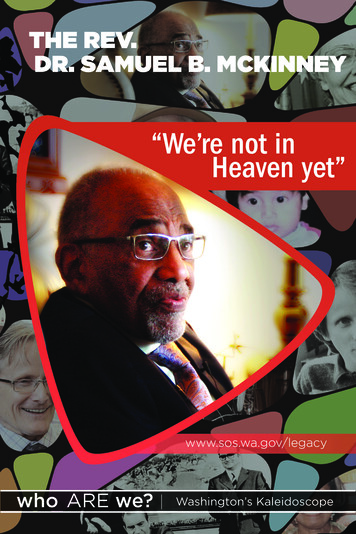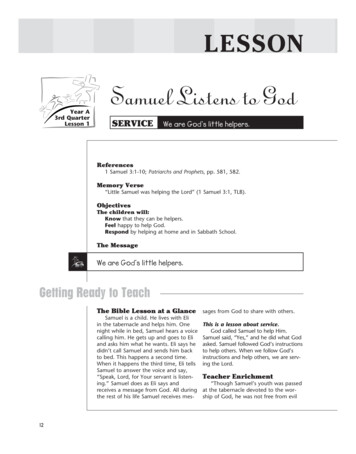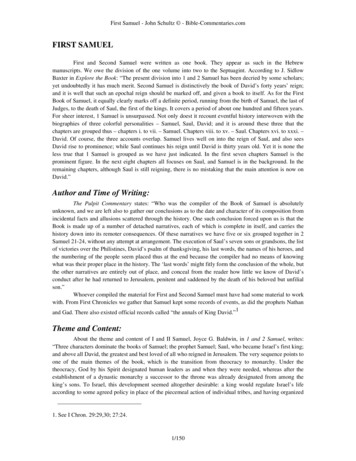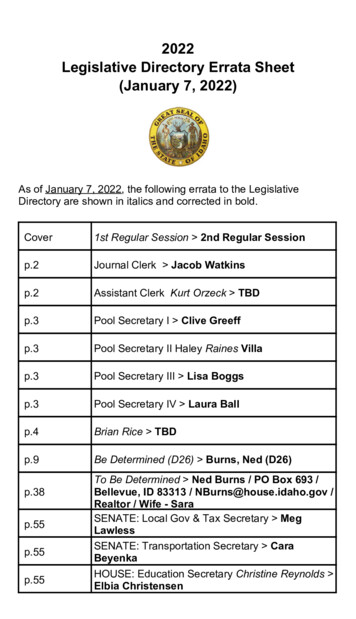
Transcription
THE REV.DR. SAMUEL B. MCKINNEY“We’re not inHeaven yet”www.sos.wa.gov/legacywho ARE we? Washington’s Kaleidoscope
“And what does the LORD require of you? But to dojustly, To love mercy, And to walk humbly with your God.”Micah 6:8They used to say Seattle was a long way from everywhere,a far-flung and hopeful place if you happened to beblack. They used to say it was another world from theDeep South where race split society at the core and dark skincould still earn you a lynching.Samuel McKinney, then on a 30-year walk with God, arrived in the city far from everywhere in the winter of 1957. “Thefrontier spirit, in a sense, is still alive,” the minister said of thePacificNorthwest.But nearly a centuryafter Lincoln freedmillions of slaves,in an ostensibly progressive city, McKinney found freedomelusive. He foundblacks banned fromrestaurants and hotels. He found themin dead-end jobs orunemployed.Hefound them running from the Southand crimes “real orimagined.” The vastmajority were confined to four squareSamuel McKinney grew up in a householdmiles of modestwhere education was revered: “Both of myparents had degrees beyond college beforehomes—some tidy,I was born. That didn’t happen in too manysome ramshackle—families, especially black families, but that wasand many built morethe case.” McKinney family collection
“We’re not in Heaven yet.”3In Seattle, a young McKinney becomes actively involved with CORE (Congress of Racial Equality). CORE, a force for social justice in the city, organizes this demonstration at a realtor’s office in 1964. Seattle Municipal Archivesthan 50 years before. Then he began house hunting himself.“Are you colored?” the realtor asked.McKinney, a third-generation Baptist minister, hadgrown up in Cleveland, Ohio hearing his father preach theSocial Gospel with such fervent passion that it passed downthe family tree to him. It rose up years later, on the streets ofSeattle, where he led boycotts against companies for refusingto hire minorities and protests against the city for refusing toopen housing. The pastor who would one day call attention tothe rebellious acts of Jesus—the Lord “raised some Holy Hell,”McKinney would write admiringly—challenged injustice onthe streets of his hometown. “The white majority should notdecide on my basic rights!” he hollered to thousands on amuddy day in Seattle. When an intimidating church leader inSeattle reneged on plans to host Martin Luther King, Jr., thendeemed a radical by whites and blacks alike, McKinney threatened to go public with the truth “so help me God!”
4The Rev. Dr. Samuel B. McKinneyThen he paid a price. He watched garbage cans shatterhis windows. He cleaned feces off the glass. He spotted BlackPanthers outside his home, their pointed rifles as visible astheir black berets. He comforted his anxious daughter whenkids on the school bus jeered, “I hear they’re going to kill yourdaddy.” After a decade, McKinney concluded that racial unrestin the Pacific Northwest didn’t mirror the Deep South, but it“certainly wasn’t the Promised Land.”This was the place where the Seattle pastor lost his friendand ally, Edwin T. Pratt. Pratt, the executive director of the Seattle Urban League leafed through the paper on a chilly January night in 1969. Snow clung to the boughs of the Douglasfirs outside his rambler in the Shoreline neighborhood northof Seattle. At approximately 8:55 p.m., a thud interrupted thequiet. It sounded like a snowball whacking the siding. “It wasa Sunday,” McKinney remembers. “And somebody kept throwing snow, throwing snowballs against his house.” Pratt lived ina mostly white neighborhood.The civil rights activist, just 38, rose warily from his sofa.“Who’s there?” Pratt asked. It was over as soon as he openedhis front door. The warning from his wife—“Look out, they’vegot a rifle!”—came too late.Pratt’s daughter, 5, had just been tucked into bed whenthe blast from a 12-gauge shotgun launched an investigationinto one of Seattle’s most notorious unsolved murders. Clueswere scant—a couple of men crouched behind a sedan in thecarport, a set of tire tracks, scattered footprints in the snow.The getaway car could have been a late-model Buick with adark-vinyl top, but no one was certain. The assailants “lookedlike kids. They were young. It was the way they ran—the gait,”someone said.News of the assassination spread quickly. “There were alot of calls on the phone and people started showing up at thehouse,” remembers Dr. Lora-Ellen McKinney, the minister’seldest daughter. “For a while, our home was always filled witha bunch of men in dark suits. But let me say this: the day thatPratt was killed didn’t feel much different than any other day.This was a murder, but painful and challenging things were
“We’re not in Heaven yet.”5happening all the time. The men in dark suits, which is how Iviewed the community leaders with whom my father worked,would show up after a rash of phone calls. There’d be a conclave and they would leave the house and get to work.”McKinney decided he would assist Pratt’s widow anddrive to the Shoreline home, roped off and swarmed by officers. “Then I had a call from one of the police and he told menot to leave home. I said, ‘Am I in some trouble?’ He told me,‘Don’t leave home.’ ”The telephone was ringing again inside McKinney’sbrick home in Madrona, just east of downtown Seattle. His8-year-old daughter, Rhoda Eileen, was usually discouragedfrom answering the home telephone. But that night she pickedup the receiver.“McKinney residence, Rhoda speaking. May I help you?”“Little girl, your daddy is next.” Rhoda let out a scream.She’d remember that night the next 46 years.Pratt’s assassins—behind a murder-for-hire authoritieswould later say—were on the run. Seattle Police placed McKinney and eight other civil rights activists on an official watchlist. One day officers pulled McKinney over on his typical route.“They asked me where I was going and I wanted to know why.I didn’t take the route that I usually took that day. I deviated.Threw them a curve. They were watching and trailing. I didfind out later that there was something that was planned. Anybody black and in a leadership position, I understand therewas a threat on them.”McKinney agonized over the safety of his wife and hischildren, but leaned on his faith. “One of the ways some forcesfunction is that they put fear into you. You back off and theyhave won.” The pastor resolved to keep going. “They can kill aperson, but they can’t stop a movement.”The Rev. Dr. Samuel B. McKinney, 89, is a memorable man,with a trademark goatee and frameless glasses. Surrounded byan array of glass awards and a replica of the Seattle street signthat now bears his name, McKinney wastes no time setting therecord straight. He’s first and foremost a minister. Not a bel-
6THE REV. DR. SAMUEL B. MCKINNEYlow-blast-and-boompreacher who shoutsin the sanctuary onSundays and retreatsto his church office.McKinney is a manof his communityseven days a week, afighter for justice.He’s still fighting. Just a few yearsago, at a vigil in Seattle for Trayvon Martin, McKinney worea crimson-and-grayhoodie—a can oficed tea in one handand a bag of skittlesin the other. Then hedenounced the Florida teenager’s killing In more than a century, no pastor at Mt. Zionand his shooter’s ac- Baptist Church has continuously preachedthan the Rev. Dr. Samuel B. McKinney.quittal: “We may not longerMcKinney family collectionbe faced with JimCrow, but we have to deal with Jim Crow’s grandson.” Whenfuror surrounded the Rev. Dr. Jeremiah Wright, the fiery former pastor of President Obama and a close personal friend ofMcKinney’s, the Seattle Baptist came to his defense. “An attackon this man of God is an attack on all those of the cloth whobelieve in the social Gospel of liberation. And I will not standfor it. Not on my watch. Not today.” McKinney has never beenone to shy away from controversy, especially where justice isconcerned. As the Rev. Dr. Gardner Taylor, the dean of American black preachers put it, fighting for what’s right might bepart of McKinney’s DNA.Frequently told he looks remarkably well for his age,McKinney offers a laugh. “Looking good is not my problem.”Life has thrown him his share of curve balls—McKinney is
“WE’RE NOT IN HEAVEN YET.”7a two-time cancer survivor. Hebecame critically ill last Juneand nearly died. McKinney’sstriking gray eyes have fadedwith time, and his voice hasquieted. But his agile mindis especially evident when herecalls the Seattle civil rightsscene of the 1960s for whichhe is best known. To truly understand Samuel Berry McKinney, however, you must tracehis roots south of the MasonDixon Line and west to MiddleAmerica.Like millions, McKinney’s ancestors fled the DeepSouth between the wars, during the Great Migration. McKStill outspoken, McKinney tells aSeattle crowd at a prayer vigil forinney’s grandfather toiled inTrayvon Martin: “We have to tell thetruth whether we like it or not, and the fields as a sharecropper. Aswe have to face up to the reality ofthe story goes, Wade Hamptonwhat is.” McKinney family collectionMcKinney I had trudged morethan 60 miles from the mountainous city of Walhalla, SouthCarolina, to the sprawling cotton fields of northeast Georgia.“You would get land according to the size of your family,” McKinney explains. “The more children you had, the more handscould work.” Wade fathered a dozen, a small army of callousedhands to pick cotton and harvest rice. One year, a violent tussleensued between the landowner, Andrew Thompson, and Wade’sson, George McKinney. “Thompson put out a posse after him,”says Lora-Ellen. “George tried to defend himself and might havekilled a couple of people in getting away.” George, 19, fled toOhio. His younger brother Wade, Samuel’s father, left for school.There weren’t many public schools open to blacks in 1910Georgia. Wade Hampton McKinney II had enrolled at AtlantaBaptist College, renamed Morehouse College in 1913. Wadewas an 18-year-old student at Morehouse with only a fifth-grade
8The Rev. Dr. Samuel B. McKinneyeducation. He’d foundthe courage to enroll after a pastor urged himto make something ofhis life. Wade studiedat the school for thenext 10 years, learningto right the wrongs ofsociety. He advanced toRochester TheologicalSeminary. In 1923, Wadewas called to a churchin Flint. The economyboomed in that Michigan town, but Jim Crowlived. The newly in- Wade Hampton McKinney II with thestalled pastor began us- Morehouse College debate team, circaing the power of the pul- 1910s. McKinney family collectionpit to further the African American struggle for equality.The fight for justice found Samuel McKinney as a boy, listening to his father’s sermons and praying to God in his Sunday best. The fight forged there, over a childhood of Sundays,in the solid oak pews of Cleveland’s Antioch Baptist Church,where the family had settled.Sure, McKinney had outside influences that shaped histhinking, strengthened his pride in his roots. He lived downthe street from Jesse Owens, the Negro youth who jumpedand sprinted his way to four Olympic Gold Medals in 1936, atthe height of Nazi power. “Ready, set, go!” McKinney and theneighbor kids yelled from an imaginary starting line outsideOwens’ home.McKinney rescued a heavyset lady who brought the frontporch down when Joe Louis knocked out Max Schmeling in thefirst round of their boxing match. “We were pulling boards backand her legs were all skinned, but she just was so happy,” McKinney remembers with a chuckle. “People can’t understand it,but when Joe Louis won a fight our race of people won.”
“We’re not in Heaven yet.”9McKinney found mostof his inspiration in the wordsof American civil rights leaders, the guest lecturers whospoke at his father’s churchand slept at the house whenthe hotels turned them away.But no one had a more profound impact on the youngMcKinney than his own father. As Samuel grew, the Rev.Dr. Wade Hampton McKinney II evolved into one of themost influential ministers inCleveland.He was a tell-it-like-itis social justice preacher. In McKinney “grew up north” in Cleve1946, after a mass lynching land, OH as the son of a prominentin Georgia, Wade marched minister. McKinney family collectionthe city streets and lamented with unflinching candor, “Thesouthern states lynch our bodies, but we know that otherslynch our very souls with discrimination and segregation. The unjustified wave of murders which have swept this country—the price paid by these martyrs—cannot be avenged orstopped by mere words, or by mere prayers alone.”In 1952, while Clevelanders grappled with housing problems, high crime and white flight, Wade called out his fellowministers, “You can’t solve a problem which you help createby your own cowardice. When Negroes move into an area youmove out—despite your instructions to go into all the worldand preach the gospel to every creature.” Wade held all blacksaccountable for change. He named one sermon “Cleveland’s148,000 Cry-Babies” and compared some Negroes to lost children. He took the city mayor to task for paying more attention to mass transit than adequate housing for African Americans. “I can almost hear the victims who have been burned todeath in these dilapidated fire traps shouting, ‘Amen’ to whatI am saying. Their blood is on somebody’s hand and I hope it
10The Rev. Dr. Samuel B. McKinneyis on somebody’s conscience as well.”In 1955, whentwo whites led Martin Luther King, Jr.away in handcuffs after the MontgomeryBus Boycott, Wadewrote the civil rightsleader. “Among themany things of whichI am sure are these:1. Prayer changesthings. 2. Moneytalks. You have myprayers, but how can “He took a lot of stands,” McKinney says ofhis father. “He stood up for justice. Morewe get some money house College produced a lot of people whoto you without violat- became social justice advocates.” McKinneying the laws of your family collectionstate?” It was the lesson the son learned from his father: Prayeris fundamental, but the pocketbook just might be the most sensitive organ in the human anatomy.When he died in 1963, it was clear that Wade McKinney’sfaith in God had never waned, and he was a great fisher of men.The elder McKinney had quadrupled his church membership,traveled the world on behalf of the Baptist Church and infusedin his son Samuel the mission of a lifetime. “He had been raisedto understand that you must lend your gift in the best way youcan,” says Lora-Ellen. “If there is an injustice, you must fix it.”The incalculable faith of his mother shaped young Samuel. Tothis day, he says she’s the finest Christian he’s ever known.Highly intelligent and the daughter of a Baptist minister, RuthBerry McKinney was a rising star in the church. She was president of the Greater Cleveland Council of American BaptistWomen, goodwill messenger for the American Baptist Foreign Mission Societies and the first black woman to be namedsecond vice president of the American Baptist Convention. In
“We’re not in Heaven yet.”111964, Ruth served on theWomen’s Committee ofthe Baptist World Alliance.Ruth was alwaysa loving, ever-presentmother, McKinney says,but she believed in punishment. She used theswitch without compunction, sending herkids off to claim theswitch before recallingthe most minor indiscretion with pinpointNothing took the place of family for RuthMcKinney, the first black woman to holdaccuracy and lightningkey positions in the Baptist Church. “Shespeed.was a mother and her children came first,”“How can youMcKinney says. McKinney family collectionkeep all that mess I did inyour mind?” Samuel would ask his mother. “ ‘On such andsuch a date you did this,such and such a date youdid that.’ ”Through the years,McKinney’sreconsidered his mother’s firmhand and concluded heneeded the discipline.His mother was fair andclear with expectations.“Don’t waste time withhalf-stepping,” she’d tellhim. “When you’re behind in a race, you haveProne to occasional mischief, McKinneyto run faster than the says he could not escape the firm handpersons up front just to of his mother or her quick recall of hisBut she was the “fineststay in the race, and even indiscretions.Christian” he’s ever known. McKinneyto get ahead.”family collection
12The Rev. Dr. Samuel B. McKinneyGrowing up, McKinneywitnessed disparities between the races—pricegouging at grocery storesin black neighborhoods,housing ordinances thatbanned people of colorfromneighborhoods,even a segregated bloodsupply.McKinneywasin high school duringthe Japanese attack onPearl Harbor. Patriotismsoared, but McKinneyMcKinney (left) and older brother Wadegrew up with twins Virginia Ruth and Mary quickly became disheartLouise. “My father said, ‘I don’t care whatened. The American Redthey do to you, don’t you touch them!’”Cross advertised a naMcKinney laughs. “So they felt they couldget away with anything.” McKinney familytionwide blood drive tocollectionassist in the war effort,but banned African American blood. The policy triggered naturalfuror. When the relief organization began segregating blood fromblack and white donors, McKinney was still disgusted. He refusedto donate to the Red Cross or his school fundraising effort on itsbehalf. “There are only four types of human blood that flow in allof our veins,” McKinney said. “They don’t accept my blood, theydon’t need my money.”McKinney also encountered racism in the military. Hewas drafted during the second semester of his freshman yearat Morehouse College. It was 1945 and the U.S. Army was stillsegregated. After basic training, and en route to Arizona, McKinney’s train pulled into a small town in Texas. Blacks were ledto a colored dining room and instructed to eat with woodenknives and cardboard plates.“Look here,” someone said.“We looked into the white dining room,” McKinney remembers. “They had silverware, cut glass stemware, tablecloths and German prisoners of war at the table. They were
“We’re not in Heaven yet.”13white. I had on a United States Army uniform. I was angry.”“How far is it to Cleveland?” Private McKinney asked.“About 1,800 miles. Are you thinking about goingAWOL?”“I’m thinking about going A-WAY.”On the brink of Samuel McKinney’s first trip to the DeepSouth, he packed his clothes in a footlocker and listened to theparting words of his father: “If you turn out to be half the manI am, you’ll do well.” “He was throwing that gauntlet of a challenge to me, which I accepted,” McKinney says.McKinney was bound for the outskirts of Atlanta andMorehouse College. “We were young and looking for a goodtime, but we were also faced with the reality of what was. It wasstill, in 1944, the racist, segregated South. My parents talked tome about staying out of trouble. They knew I had a big mouth.”McKinney saw an altogether different world in Atlanta—colored and white drinking fountains, colored and white restrooms, the occasional run-in with an unfriendly salesman.One of them threw shoes at him after querying his size. Atthe city’s oldest social club, McKinney witnessed retaliation byblack food-service workers who quietly took umbrage at racist comments. “Officers who were white would get togetherWade Hampton McKinney II and his son Samuel, one of theonly father-son pairings honored with portraits in the Morehouse College International Hall of Honor. Ho-Eun Chung
14The Rev. Dr. Samuel B. McKinneyand talk about how their Negro troops were doing. They forgot there were blacks who worked there.” The black workerswould doctor the food they served them. Sometimes the whiteofficers “would get sick and have to be replaced.”Once settled into life at Morehouse, McKinney rekindleda friendship with Martin Luther King, Jr., a fellow minister’sson who’d enrolled before formally graduating from highschool. “How could you enter college at 15? World War II wason,” McKinney says. “The enrollment for males was down allover the country. The State of Georgia came up with a law thatif you took a test in the eleventh grade and passed it, you couldbypass the twelfth grade and go directly into college.”King’s reputation at Morehouse did not match the reverence that later surrounded him when he became a storied civilrights leader. Though he stood 5-9 as an adult, the 15-year-oldKing was called “Runt” by his peers. The author of one of history’s most celebrated speeches had yet to win a single oratorical contest. “He tookpart in every oratoricalcontest on the campusat that time. And didn’twin,” McKinney remembers.Their friendshippredated college. McKinney says he’d bumpinto King at religiousconventions when theywere young boys tryingto escape all the “hotair” from their preacher fathers. Their livestook similar turns.Both followed their faTheir longtime friendship influencedthers to Morehouse.McKinney’s life. McKinney met MartinLuther King Jr. when they were boys atBoth were swayed toreligous conventions trying to escape thethe ministry by Dr.“hot air” of their preacher fathers.Benjamin Mays, theMcKinney family collection
“We’re not in Heaven yet.”15college president who introduced King to Gandhian philosophy. Later, in 1954, both were up for the same job. The PulpitCommittee at Montgomery’s famous Dexter Avenue BaptistChurch was vetting two candidates to assume the role of itslead pastor: Martin Luther King, Jr. and Samuel Berry McKinney. King would later accept the offer, directing the well-knownbus boycott from the church office. McKinney says he never seriously considered a move south and adds with a grin: “I askedthe Lord if he would go with me from Cleveland to Montgomery and he said he would go as far as Cincinnati.”When Samuel McKinney first took the pulpit in Seattle in1958, World War II had changed the face of the city. Wartimejobs had grown the black population a whopping 300 percentin a single decade. From his new post at Mount Zion BaptistChurch—among the oldest and largest black churches in thestate—McKinney sized up his congregation and his new community. “A lot of African Americans were trying to run awayfrom their history or deny it when I first came here,” McKinney says. “There was a term they used—‘escapist Negroes.’ ”Most lived and worked in the Central Area, a once most-The Central Area, home to most of the city’s blacks, is among the oldestneighborhoods in Seattle. Restrictive covenants forced most people ofcolor to live in the district. Open housing would not pass in Seattle until1968. Seattle P-I
16The Rev. Dr. Samuel B. McKinneyMcKinney begins the first day of more than 40 years at Seattle’s famous Mt.Zion Baptist Church. Above, McKinney with his parents, daughter LoraEllen, wife Louise and his great aunt-, Ada Berry. McKinney family collectionly Jewish neighborhood between Lake Washington and theCentral Business District. Barber shops, doctor’s offices andrestaurants owned by African Americans were now neighborhood fixtures.Many people of color lived in the neighborhood’s lowrise apartments, bungalows or aging wood-framed walkups.The houses were either “plain and bulky” or “plain and shacklike,” as one resident put it. And there were pockets of neglect.But restrictive covenants banned minorities from many otherSeattle neighborhoods. McKinney and his wife Louise spentsix months house hunting, often encountering realtors who’dbrazenly ask their color of skin over the phone.Even at the grocery store in 1958 Seattle, McKinneyfound a tense racial climate, the occasional surge of uneasiness among white patrons. He’d stand in line with his cart andnotice the white shopper ahead of him wheeling away. “No,no, I can wait,” a patron told him on more than one occasion.“They were afraid somebody might come” in and stage a holdup, McKinney says. “They didn’t want to be in the line of theshooting.”
“We’re not in Heaven yet.”17Many black Seattleites were unemployed orworking dead-end or lowpaying jobs. They senttheirchildren—some9,000 in the 1960s—tonearly all-black schools.In an era of de facto segregation, 80 percent of African American studentsattended a small cluster ofschools, usually in or nearthe Central Area.“Every part of thiscountry has been affected by racism,” McKinney says. “A lot of folksMcKinney has leaned on his faith allhave had social amnesiahis life, taking to heart the words of hisfavorite Bible verse: “And what does thesince it was better thanLORD require of you? But to do justly,the place they came from.To love mercy, And to walk humbly withyour God.” Micah 6:8People thought when theyMcKinney family collectiongot here they were in thePromised Land. I don’t know what had been promised to them.The problem has been here all the time. It’s the same here asanywhere else. The difference is a matter of degree.”Like his father, the pastor used the power of the pulpit topush for change. “The church provides the crowds. It is part ofa system that has a long history of operation. History will tellyou that every slave insurrection movement was led by a Negropreacher. Championing the cause of civil rights has always beenpart of the function of a Negro minister.”McKinney devoted his time to organizations on the frontlines of the civil rights battlefield: the Friends Against Racial Discrimination, the Congress of Racial Equality, the Central AreaCivil Rights Committee and the Greater Council of Churches.His seminal achievement, however, came about in 1961.The 3,000 check was sent a year earlier, “unsought, unre-
18The Rev. Dr. Samuel B. McKinneyquested and unsolicited” from McKinney and other clergymen.But it prompted a telling question from McKinney’s formerMorehouse classmate: “What do you want?” asked Martin Luther King, Jr., now a national figure.The Brotherhood of Mount Zion Baptist Church had invited the civil rights leader to give a series of speeches in Seattle.King, 32, was controversial. He’d received threatening phonecalls. His home in Montgomery had been bombed. He’d survived a stabbing attempt during a book signing in Harlem. ButMcKinney believed the country’s leading voice for civil rightswould send the right message to Seattle at the right time. “Alot of people had never seen him and wanted to hear him. Wewanted him to come in and address us here. And he agreed.”The forthcoming King visit to Seattle sparked controversy.Conservative blacks worried his visit would trigger racial disputes. Some of McKinney’s parishioners found anti-King material on their desks at Boeing. One parent of a student at GarfieldHigh School, where King was scheduled to speak, raised concerns about the leader’s rumored ties to the Communist Party.McKinney wrote King, alerting him of circumstances surrounding his scheduled tour. “An extreme conservative rightwing element, whose presence is a known factor on the westcoast, have been quite vocal about your coming. The total community, which far exceeds the Negro population of 27,000, isquite aroused over some incidents that have occurred relative toyour visit here. We have worked exceedingly hard to gain citywide support for your first visit to the Pacific Northwest, and thatsupport is guaranteed now more than ever.”While King’s entire visit was controversial, one stop provedespecially contentious. In 1961, Seattle was inundated with massive construction projects for the Century 21 Exposition. The1962 World’s Fair limited the number of available venues thatcould accommodate large crowds. McKinney settled on SeattleFirst Presbyterian Church at 8th and Madison, a great barnlikebuilding that could hold some 3,000 people. He counted ona gentleman’s agreement and began publicizing the speech.“We got closer to it and started announcing it,” McKinney says.“There was some kickback at the church.”
“We’re not in Heaven yet.”19First Presbyterian canceled the speech, triggering an unforgettable encounter between McKinney and the church layleader who was also a lawyer. The imposing attorney, with his6-2 frame and white flowing mane, had a “voice that could strikefear in judge and jury.”McKinney can still hear his booming voice: “You did notfollow proper procedures. But I know you’ve spent money. Giveus a bill and we’ll pay for it.”“We didn’t come down here asking for any money,” McKinney told him. “We don’t want your money.”“What did you say?”“You heard me. Nobody told us that there were any hoopsto jump through, papers to sign and documents. You never toldus that. But that’s okay, Dr. King will be in town, he will speak.And I think I ought to let you know—this is not a threat—butwe are going to tell the world about what happened.”“Well, tell the truth,” the attorney responded.“Nothing but the truth, so help me God!”“Right is right,” McKinney says. “We had an agreementand we were upholding our end of the bargain. Now you want toback down because some folks are bigoted and racist and don’twant to have Dr. King speak here.”“You’ll look back and thank them,” King said when heheard the news. “Some people can kick you upstairs whenthey’re trying to put you downstairs.’”During his historic visit in 1961, King tells throngs of Seattleites, “In orderfor democracy to live, segregation must die.” Washington State Archives,Sam Smith papers
20The Rev. Dr. Samuel B. McKinneyThe cancellation generated headlines.King’s November visit would mark his only visit to Seattle and the last time he would travel alone. He reported bombthreats on the airplanes he flew and suspicious-looking menwho seemed to be tailing him in Chicago and Birmingham.When he arrived that November, the prominent figure’s message of nonviolence, his plea to President Kennedy to outlawsegregation by executive order, his admonition that young people were imperative to the movement, were met with roaringapplause all over Seattle. To some 2,000 University of Washington students packed into Meany Hall, King said, “The student movements have done more to save the soul of the nationthan anything I can think of. We’ve broken loose from theEgypt of slavery and stand on the border of the promised landof int
Threw them a curve. They were watching and trailing. I did find out later that there was something that was planned. Any-body black and in a leadership position, I understand there was a threat on them." McKinney agonized over the safety of his wife and his children, but leaned on his faith. "One of the ways some forces










